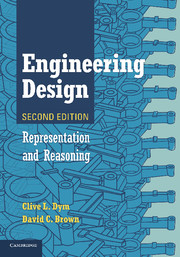Book contents
- Frontmatter
- Contents
- Preface
- Preface to the First Edition
- Acknowledgments
- 1 Framing the Issues
- 2 Engineering Design
- 3 Characterizing the Design Process
- 4 Taxonomies of Engineering Design
- 5 Representing Designed Artifacts
- 6 Representing Design Processes
- 7 Where Do We Go from Here?
- References Listed in First Edition
- New References
- Index
6 - Representing Design Processes
Published online by Cambridge University Press: 05 June 2012
- Frontmatter
- Contents
- Preface
- Preface to the First Edition
- Acknowledgments
- 1 Framing the Issues
- 2 Engineering Design
- 3 Characterizing the Design Process
- 4 Taxonomies of Engineering Design
- 5 Representing Designed Artifacts
- 6 Representing Design Processes
- 7 Where Do We Go from Here?
- References Listed in First Edition
- New References
- Index
Summary
We now complete our discussion of representing design knowledge by turning to the representation of the design process in terms of the languages of design that we identified in Chapter 5. We take a path parallel to that of the previous chapter as we show how AI-based problem-solving methods can be used to model the ways we solve design problems, as well as how we represent the kinds of design knowledge we use to solve design problems.
Classical Design Methods
In Chapter 3, we described several prescriptive models of the design process. Inherent in these prescriptions is a disposition toward inductive reasoning wherein we try to induce or infer a solution to a design problem by filling in incomplete information or knowledge. We might contrast this with a deductive approach to design wherein, in its most prevalent implementation, we deduce solutions to our current design problem from case studies of previous designs. As discussed in Section 6.2, there is a rough analogy here between using a set of rules to analyze the meaning of a set of symptoms or conditions, in which case we are reasoning deductively, and using a set of rules to work “backward” from a set of desired goals in order to find the conditions that would allow us to achieve those goals, given the rules under which we are operating. In the latter case, clearly, we are reasoning more inductively than deductively. The classical or traditional methods that we describe in this section are clearly informed by and support the inductive nature of the design-process prescriptions presented earlier (cf. Section 3.3).♦
- Type
- Chapter
- Information
- Engineering DesignRepresentation and Reasoning, pp. 113 - 154Publisher: Cambridge University PressPrint publication year: 2012



